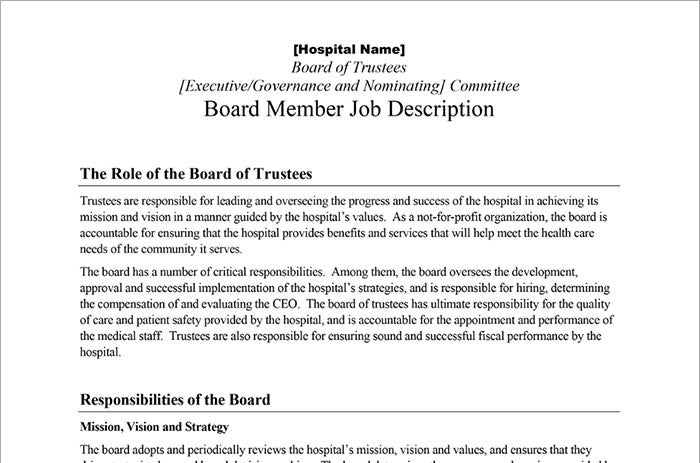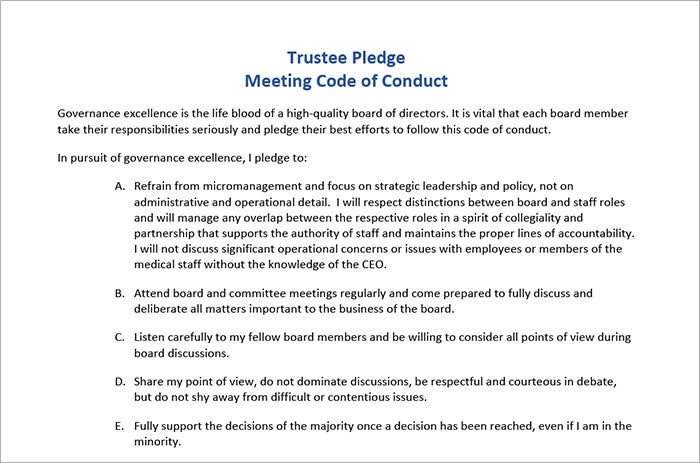
Board and CEO Relations
Is Your Board of Trustees Micromanaging Your CEO?
10 tips for setting governance boundaries
By Todd C. Linden
A common question and one that all boards wrestle with at one time or another is: Are we micromanaging our CEO?
After working for boards as a hospital CEO for over 30 years, serving on dozens of boards and now consulting with boards across America, one of the most important questions I hear is this: Where is the line between governance and management?
The line, I’ve found, is often a blurry one.
A successful board must fulfill its duties of care, obedience and loyalty by analyzing all sides of an issue, fully debating it and, ultimately, reaching a conclusion. To get there, one board may only ask a few — or even zero — questions about a major proposal by management and then vote it through. Another board may ask many probing questions, some of which might leak into “management” issues. Is the first board abdicating its duty of care and merely rubber-stamping decisions? Is the second board giving orders, getting into the weeds and making for unnecessarily long meetings?
The hard truth is each board must set its own boundaries on governance versus management decisions. In addition, boards must continuously revisit this line. Too often boards do not take this distinction into account and bump along without taking the time to consider how effective they are in their governance activities.
How can a board and CEO work together to lead an organization well? Consider these 10 tips for helping boards stay in their lane while fulfilling governance obligations:
1] Clearly define the role of the board and the CEO.
It’s important to get the roles in writing with job descriptions. The more specific the descriptions, the less likely for role wondering. Every organization typically has a CEO job description. Do you have one for board members?
2] Talk about it.
At least annually, complete a governance performance assessment. Incorporate questions that probe the micromanagement issue. Discuss the results and make plans to improve if necessary. Another best practice is to take five minutes for evaluation at the end of each board meeting and ask the following three questions: What did we do well? Where could we have done better? Did we stay in our lane?
3] Consider both the topic and the tenure of board members.
Acknowledge when it is necessary to understand an issue at a deeper level. A difficult topic might require a discussion that gets into the weeds. A board with seven members who have an average of nine years of service and a CEO who has been with the organization for over a decade will require less discussion on an issue than a board with 15 members that includes four new members and a CEO in their first year. Obviously, strong orientation and ongoing board education programs make a difference. Younger tenured boards are going to ask more questions. Do not confuse hard questions, a good debate or a long discussion about a complex issue as micromanagement. The duty of care may require challenging and probing questions. Newer board members will need more information.
4] Understand the CEO sometimes wants advice and counsel on a management issue.
There is great value in receiving competent advice from board members who care about an organization. When doing this, it is important to describe it as a nongovernance issue that will not require a vote. There were many times over my 30 years as a CEO when I had a sticky or complex management issue and simply wanted advice from my board. I wanted the collective wisdom of the room. I opened the management window and invited the board in. At the end of the discussion, I would make it clear that I was closing the management window and we would move on to the next governance issue. It takes trust to make sure the board will not use this opportunity to insert itself into other management issues uninvited.
5] Do your homework.
Boards that get well-developed, concise briefing materials prior to the board meeting and thoroughly prepare will spend less time asking questions and crossing into the management lane. It seems like about a third of the board comes prepared, a third skims the material the day of the meeting and a third never opens the board book prior to the meeting. Challenge your board to do better. Challenge your administration to create tight, well-conceived board packets that are shared in a timely manner. The more time spent creating best-practice board packets instills confidence, and boards fully utilizing them will dramatically reduce any time spent in board meetings getting into the weeds.
6] Mind your agenda development and governing mode.
Richard Chait, Barbara Taylor and William Ryan’s work on the different governing modes have implications for keeping governance above the management line. They describe three distinct modes: 1) fiduciary, where oversight is the focus; 2) strategic, which centers on foresight; and 3) generative, which keys in on the insight the board brings to the table. In an ideal world, the board sets the priority on the “what” and management focuses on the “how.” That said, depending on the governing mode, the board may need to get into the “how.” For example, a fiduciary responsibility of quality or financial oversight may require some probing questions when a problem is identified. Building a robust board education program with an annual deep dive on health care finance and clinical quality may well stave off monthly questions on routine oversight activities. Clearly framing an issue when in generative mode may well get deeper into an issue.
Overloading an agenda with all oversight items and lots of reports may get boring and seem like all a leader wants is a board to rubber-stamp items. Too many generative agenda items will lengthen meetings and could be overwhelming, especially to new board members. Being thoughtful about crafting an agenda with the right mix of fiduciary, strategic and generative items can greatly enhance the work of the board and reduce the opportunity for micromanagement. One additional tip: Label agenda items as “oversight,” “foresight” and “insight” to give board members a sense of which governing mode they will be using.
7] Assign a “micromanagement detective.”
Many board chairs are responsible for constantly assessing the meeting and watching for governance creep into the management realm. If that is the case, has the role clearly been spelled out in the board chair’s job description? Some boards prefer to assign this role to someone other than the board chair. Either way is fine, just make sure at least one board member has the responsibility to constantly monitor the board’s activity and call it out when the discussion gets off track. In your organization, who is responsible for monitoring and asking, “Are we getting off track?”
8] Keep the communication channels open with the CEO about micromanagement.
It can be hard, especially for a new CEO, to tell their bosses that they are stepping over the line. The board needs to ask and encourage the CEO to share their thoughts when it feels like the board is venturing into the management lane. The more trust established, the easier it is for the CEO to be honest and direct with the board when micromanagement occurs. Pay attention to this issue. No one likes to be micromanaged, and it is one of the leading reasons CEOs leave hospitals.
9] Guard against a perception that board members feel pressured to not ask questions.
Board members, especially if new, should feel comfortable asking questions if they do not understand the issue or its complexity. I have sometimes heard board members say, “I was afraid I would be accused of getting into the weeds.” High-performing boards have mentors who can work with new board members outside the meeting to help with this. Encourage new board members to jot down questions during meetings to share with their mentors. This supports new board members through the steep learning curve hospital board leadership requires.
10] Consider adopting a “meeting code of conduct” or “trustee pledge.”
I use a set of guiding principles to help with this. The 12 points in the principles outline the role of governance and meeting best practices. It has helped the boards I’ve worked with stay in governance mode and serves as a constant reminder of how the board can follow good practices.
Board dynamics greatly influence how governance and management are handled. Really great boards work at it, constantly assessing their performance. The truth is the governance versus management line is blurry and always changing as the dynamics of a board evolves. Using these tips will help your board find the line, refine it and continuously improve it.
Todd C. Linden (tlinden@lconsult.org) is a partner of Linden Consulting, adviser for GHI governWell and CEO emeritus of Grinnell (Iowa) Regional Medical Center.
Please note that the views of authors do not always reflect the views of the AHA.


